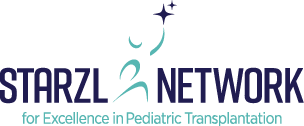What We Do
Network Projects
The Starzl Network for Excellence in Pediatric Transplantation serves to improve long-term outcomes for all children everywhere. View our educational resources and current network projects for patients, families and health care professionals.
Medical and Surgical Techniques
Anticoagulation Best Practices
Goals
- To optimize anti-coagulation practices and monitoring after liver transplant.
- To minimize thrombotic complications.
- To promote efficiency and excellence in surgical practices that enhance organ availability in children.
Initial Objectives
- To investigate current protocols for intra-operative monitoring of arterial and portal flow and coagulation status.
- To associate anti-coagulation with intra-and post-operative outcomes.
Accomplishments
- Shared post-transplant anti-coagulation protocols across Starzl centers.
- Designed and piloted data collection forms to track impact of peri-operative anti-coagulation on outcomes (e.g. hepatic artery, portal vein thrombosis).
- Created a listserv to facilitate transplant surgeon communication, particularly for discussion of difficult cases.
- Developed a multidisciplinary team to broaden the potential scientific understanding of peri-operative thrombotic and bleeding complications.
Optimizing Immunosuppression
Goal
- To optimize immunosuppression—providing enough to protect the liver allograft while minimizing burden on the child and family.
Initial Objectives
To explore how variation in early immunosuppression regimen impacts immunosuppression-related outcomes.
Accomplishments
- Shared post-transplant immunosuppression protocols
- Identified key areas of variation in protocols
- Use of antibody induction, +/- corticosteroids
- Addition of mycophenolate mofetil
- Designed benchmarking report, based on SPLIT registry data, that centers can use to evaluate the impact of early immunosuppression (0-3 months) on early outcomes (first year: survival, rejection, infections, medication adverse effects)
- Creating survey to ask patients and families what aspects of immunosuppression create the biggest burden on their lives
Community & Family Projects
Patient & Family Voice
Goals
- To support and unite the global pediatric transplant community through collaboration with transplant community stakeholders.
- To develop and implement innovative ideas.
- To advocate and improve the lives of all pediatric transplant patients and their families.
Initial Objective
To integrate patients and families within all Starzl Network activities including executive LHS network planning and individual project working groups.
Accomplishments
- Finalized PFV Mission Statement
- Formalized PFV leadership structure including roles and responsibilities of three lead representatives and center delegates
- Developed onboarding process for new PFV members
- Identified PFV passion and pain points associated with various time points throughout the transplant process (i.e. pre-, peri-, short-term post-, long-term post-transplant)
- Provided direct patient/family feedback to project teams regarding implementation strategies (i.e. PeLTQL) and project outcomes (i.e. Transition of Care)
Adoption of the Pediatric Liver Transplant Quality of Life (PeLTQL) Survey
Goal
- To systematically hear patient (and parent) voices in care provided after liver transplant.
Initial Objectives
To assess feasibility of using a pediatric liver transplant-specific quality of life tool (PeLTQL) in Starzl pediatric liver transplant clinics.
Accomplishments
- Completed a pilot study administering the PeLTQL to 30 patient-parent dyads at 5 sites, solicited feedback from patients, parents and clinical team members via Survey-Monkey, implemented an excel calculator for expedited scoring.
- Participating centers shared strategies for successfully implementing the PeLTQL in their clinics, with additional 84 completed patient-patient dyads at all sites.
- Developed an e-PeLTQL with automated scoring for easier utilization in the clinic setting.
Understanding Variations in Transition of Care Resources & Practices
Goal
- To identify predictors of successful transition of care and develop evidence based guidelines for preparing adolescents, young adults and their parents for successful transition.
Initial objectives
- To assess the current state of transition programs within the Starzl Network.
- To track outcomes of patients transferred from pediatric to adult healthcare.
Accomplishments
- Surveyed Starzl centers on existing practices in transition of transplant care from the pediatric to adult care team. Areas assessed included: program status, interventions, team involvement, adult provider engagement, challenges, and monitoring outcomes.
- Currently assessing the number of patients transferred to adult care by each center over the last 5 years and their outcomes.
Network Working Groups
Surgeons Working Group
Mission
To advocate and help disseminate surgical best practice in pediatric liver transplantation
Adaptive Trial Design Working Group
Mission
To determine the impact of adaptive trial designs on pediatric transplantation innovation
Social Determinants of Health Working Group
Mission
To discover strategies to identify disparities and improve outcomes for children facing social adversity across the liver transplant continuum.
